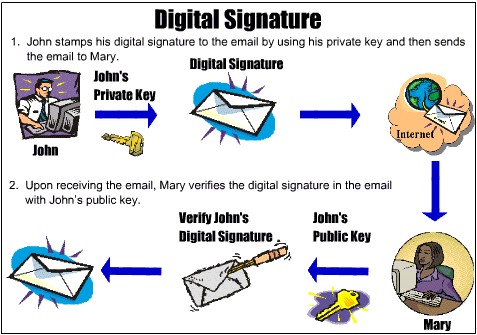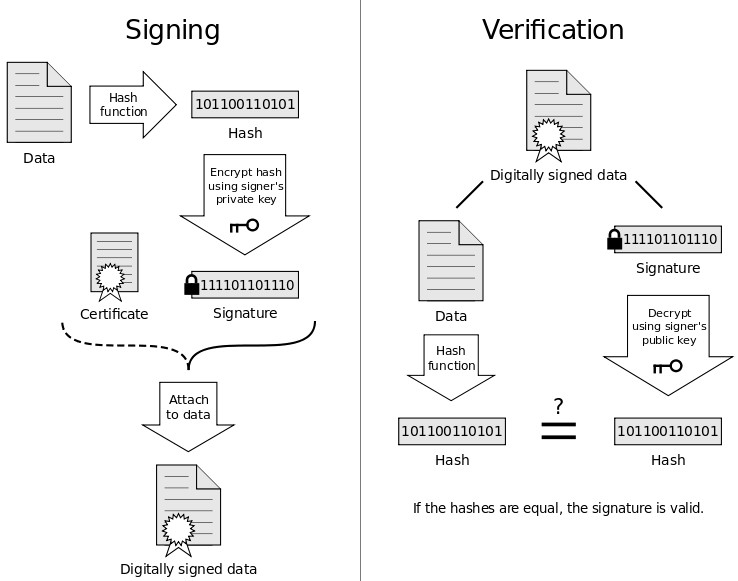A digital signature is an electronic signature that can be used to authenticate the identity of the sender of a electronic document (e-mail, spreadsheet, text file, etc.) thus, ensuring that the original content of the electronic document is unchanged. Digital signatures are easily transportable, cannot be imitated by someone else, and can be automatically time-stamped. The ability to ensure that the original signed message arrived means that the sender cannot easily repudiate it later.
A digital signature can be used with any kind of message, whether it is encrypted or not, simply so that the receiver can be sure of the sender’s identity and that the message arrived intact. A digital certificate contains the digital signature of the certificate-issuing authority so that anyone can verify that the certificate is real.
Digital Signature Working
Assume John need to send a contract to Mary in another town. John wants to give Mary the assurance that it was unchanged from what John sent and that it is really from John.
- John copy-and-paste the contract (it’s a short one!) into an e-mail note.
- Using special software, John obtains a message hash (mathematical summary) of the contract.
- John then use a private key that John have previously obtained from a public-private key authority to encrypt the hash.
- The encrypted hash becomes John digital signature of the message. (Note that it will be different each time John sends a message.)
At the other end, Mary receives the message.
- To make sure it’s intact and from John, Mary makes a hash of the received message.
- Mary then uses John’s public key to decrypt the message hash or summary.
- If the hashes match, the received message is valid.

A digital signature is a mathematical scheme for demonstrating the authenticity of a digital message or document. A valid digital signature gives a recipient reason to believe that the message was created by a known sender, such that the sender cannot deny having sent the message (authentication and non-repudiation) and that the message was not altered in transit (integrity). Digital signatures are commonly used for software distribution, financial transactions, and in other cases where it is important to detect forgery or tampering.
Digital signatures are often used to implement electronic signatures, but not all electronic signatures use digital signatures. In some countries, including the United States, India, Brazil, and members of the European Union, electronic signatures have legal significance.
Digital signatures employ a type of asymmetric cryptography. For messages sent through a non-secure channel, a properly implemented digital signature gives the receiver reason to believe the message was sent by the claimed sender. Digital signatures are equivalent to traditional handwritten signatures in many respects, but properly implemented digital signatures are more difficult to forge than the handwritten type. Digital signature schemes, in the sense used here, are cryptographically based, and must be implemented properly to be effective. Digital signatures can also provide non-repudiation, meaning that the signer cannot successfully claim they did not sign a message, while also claiming their private key remains secret; further, some non-repudiation schemes offer a time stamp for the digital signature, so that even if the private key is exposed, the signature is valid. Digitally signed messages may be anything represented as a string of bits like electronic mail, contracts, or a message sent via some other cryptographic protocol. A digital signature scheme typically consists of three algorithms
- A key generation algorithm that selects a private key uniformly at random from a set of possible private keys. The algorithm outputs the private key and a corresponding public key.
- A signing algorithm that, given a message and a private key, produces a signature.
- A signature verifying algorithm that, given a message, public key and a signature, either accepts or rejects the message’s claim to authenticity.
Two main properties are required. First, the authenticity of a signature generated from a fixed message and fixed private key can be verified by using the corresponding public key. Secondly, it should be computationally infeasible to generate a valid signature for a party without knowing that party’s private key.

Below are some common reasons for applying a digital signature to communications:
Authentication
Although messages may often include information about the entity sending a message, that information may not be accurate. Digital signatures can be used to authenticate the source of messages. When ownership of a digital signature secret key is bound to a specific user, a valid signature shows that the message was sent by that user. The importance of high confidence in sender authenticity is especially obvious in a financial context. For example, suppose a bank’s branch office sends instructions to the central office requesting a change in the balance of an account. If the central office is not convinced that such a message is truly sent from an authorized source, acting on such a request could be a grave mistake.
Integrity
In many scenarios, the sender and receiver of a message may have a need for confidence that the message has not been altered during transmission. Although encryption hides the contents of a message, it may be possible to change an encrypted message without understanding it. (Some encryption algorithms, known as nonmalleable ones, prevent this, but others do not.) However, if a message is digitally signed, any change in the message after signature invalidates the signature. Furthermore, there is no efficient way to modify a message and its signature to produce a new message with a valid signature, because this is still considered to be computationally infeasible by most cryptographic hash functions (see collision resistance).
Non-repudiation
Non-repudiation, or more specifically non-repudiation of origin, is an important aspect of digital signatures. By this property, an entity that has signed some information cannot at a later time deny having signed it. Similarly, access to the public key only does not enable a fraudulent party to fake a valid signature.
Note that this authentication, non-repudiation etc. properties rely on the secret key not having been revoked prior to its usage. Public revocation of a key-pair is a required ability, else leaked secret keys would continue to implicate the claimed owner of the key-pair. Checking revocation status requires an “online” check, e.g. checking a “Certificate Revocation List” or via the “Online Certificate Status Protocol”. Very roughly this is analogous to a vendor who receives credit-cards first checking online with the credit-card issuer to find if a given card has been reported lost or stolen. Of course, with stolen key pairs, the theft is often discovered only after the secret key’s use, e.g., to sign a bogus certificate for espionage purposes.

